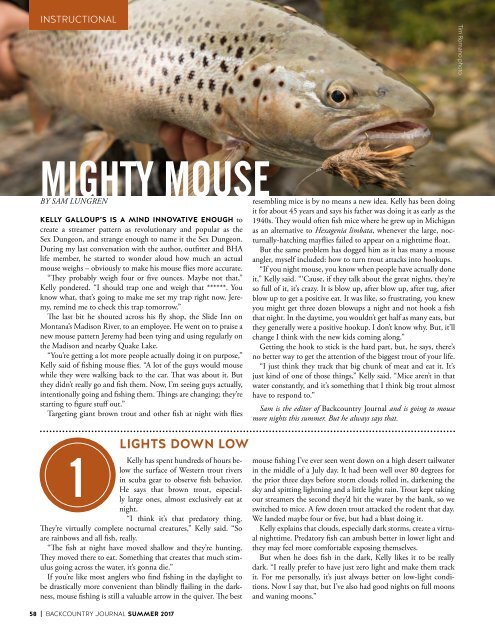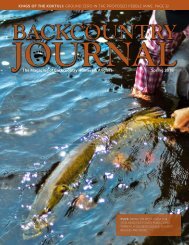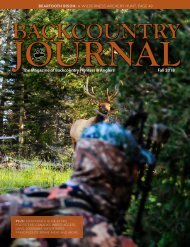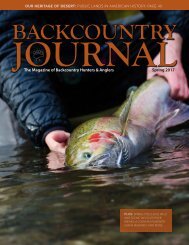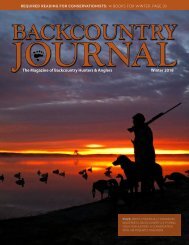BCJ_SUMMER17 Digital Edition
Create successful ePaper yourself
Turn your PDF publications into a flip-book with our unique Google optimized e-Paper software.
INSTRUCTIONAL<br />
Tim Romano photo<br />
SCURRY<br />
2<br />
“What you should do is grab a<br />
mouse and throw it in the water and<br />
watch him try to run across there. I<br />
try to make that happen,” Kelly said.<br />
“I don’t do, on anything, a steady retrieve.<br />
Ever. From a caddis to a fleeing<br />
bait fish to a mouse. They don’t tend<br />
to be real consistent. I’ve hucked them in the lake and watched<br />
them. They take off.”<br />
Many anglers, he says, fish a mouse slowly and consistently,<br />
swinging down and across like one might skate a waked fly for<br />
steelhead or Atlantic salmon. Real mice know the dangers that<br />
lurk beneath the surface and try to spend as little time in the<br />
water as possible.<br />
“I’ve seen them go 20 feet without stopping, in a total panic,”<br />
Kelly said. “You can see it’s panic. They’re not doing exercise laps.<br />
A lot of guys like to make them go real consistent. I don’t. I’m just<br />
trying to mimic nature.”<br />
MIGHTY MOUSE<br />
BY SAM LUNGREN<br />
KELLY GALLOUP’S IS A MIND INNOVATIVE ENOUGH to<br />
create a streamer pattern as revolutionary and popular as the<br />
Sex Dungeon, and strange enough to name it the Sex Dungeon.<br />
During my last conversation with the author, outfitter and BHA<br />
life member, he started to wonder aloud how much an actual<br />
mouse weighs – obviously to make his mouse flies more accurate.<br />
“They probably weigh four or five ounces. Maybe not that,”<br />
Kelly pondered. “I should trap one and weigh that ******. You<br />
know what, that’s going to make me set my trap right now. Jeremy,<br />
remind me to check this trap tomorrow.”<br />
The last bit he shouted across his fly shop, the Slide Inn on<br />
Montana’s Madison River, to an employee. He went on to praise a<br />
new mouse pattern Jeremy had been tying and using regularly on<br />
the Madison and nearby Quake Lake.<br />
“You’re getting a lot more people actually doing it on purpose,”<br />
Kelly said of fishing mouse flies. “A lot of the guys would mouse<br />
while they were walking back to the car. That was about it. But<br />
they didn’t really go and fish them. Now, I’m seeing guys actually,<br />
intentionally going and fishing them. Things are changing; they’re<br />
starting to figure stuff out.”<br />
Targeting giant brown trout and other fish at night with flies<br />
58 | BACKCOUNTRY JOURNAL SUMMER 2017<br />
LIGHTS DOWN LOW<br />
1<br />
Kelly has spent hundreds of hours below<br />
the surface of Western trout rivers<br />
in scuba gear to observe fish behavior.<br />
He says that brown trout, especially<br />
large ones, almost exclusively eat at<br />
night.<br />
“I think it’s that predatory thing.<br />
They’re virtually complete nocturnal creatures,” Kelly said. “So<br />
are rainbows and all fish, really.<br />
“The fish at night have moved shallow and they’re hunting.<br />
They moved there to eat. Something that creates that much stimulus<br />
going across the water, it’s gonna die.”<br />
If you’re like most anglers who find fishing in the daylight to<br />
be drastically more convenient than blindly flailing in the darkness,<br />
mouse fishing is still a valuable arrow in the quiver. The best<br />
resembling mice is by no means a new idea. Kelly has been doing<br />
it for about 45 years and says his father was doing it as early as the<br />
1940s. They would often fish mice where he grew up in Michigan<br />
as an alternative to Hexagenia limbata, whenever the large, nocturnally-hatching<br />
mayflies failed to appear on a nighttime float.<br />
But the same problem has dogged him as it has many a mouse<br />
angler, myself included: how to turn trout attacks into hookups.<br />
“If you night mouse, you know when people have actually done<br />
it,” Kelly said. “‘Cause, if they talk about the great nights, they’re<br />
so full of it, it’s crazy. It is blow up, after blow up, after tug, after<br />
blow up to get a positive eat. It was like, so frustrating, you knew<br />
you might get three dozen blowups a night and not hook a fish<br />
that night. In the daytime, you wouldn’t get half as many eats, but<br />
they generally were a positive hookup. I don’t know why. But, it’ll<br />
change I think with the new kids coming along.”<br />
Getting the hook to stick is the hard part, but, he says, there’s<br />
no better way to get the attention of the biggest trout of your life.<br />
“I just think they track that big chunk of meat and eat it. It’s<br />
just kind of one of those things,” Kelly said. “Mice aren’t in that<br />
water constantly, and it’s something that I think big trout almost<br />
have to respond to.”<br />
Sam is the editor of Backcountry Journal and is going to mouse<br />
more nights this summer. But he always says that.<br />
mouse fishing I’ve ever seen went down on a high desert tailwater<br />
in the middle of a July day. It had been well over 80 degrees for<br />
the prior three days before storm clouds rolled in, darkening the<br />
sky and spitting lightning and a little light rain. Trout kept taking<br />
our streamers the second they’d hit the water by the bank, so we<br />
switched to mice. A few dozen trout attacked the rodent that day.<br />
We landed maybe four or five, but had a blast doing it.<br />
Kelly explains that clouds, especially dark storms, create a virtual<br />
nighttime. Predatory fish can ambush better in lower light and<br />
they may feel more comfortable exposing themselves.<br />
But when he does fish in the dark, Kelly likes it to be really<br />
dark. “I really prefer to have just zero light and make them track<br />
it. For me personally, it’s just always better on low-light conditions.<br />
Now I say that, but I’ve also had good nights on full moons<br />
and waning moons.”<br />
SLOW THE SET<br />
BOOTY SWING<br />
4<br />
After once pulling five dead shrews<br />
out of a dead brown trout’s stomach,<br />
he briefly got excited about fishing two<br />
mouse flies at a time – anything to make<br />
mouse fishing more effective.<br />
“On the first night I fished them tandem,<br />
and I got a double and I thought<br />
‘Holy crap, I cracked the code’ and ‘Oh my God, I’m a genius!’”<br />
Kelly said. “Then I never got another fish on when I was running<br />
it tandem. So that was out the window.”<br />
He tried everything from a big treble hook on the tail to many<br />
tiny treble hooks along the tail. Hooks on bottom, hooks on top,<br />
EXPERIMENT<br />
3<br />
“You tend to beat your fish,” Kelly<br />
said. “On the hook set, really, if you<br />
can compose yourself, just like with a<br />
steelhead eat, feel it pull and set the<br />
hook. Don’t rail on it when you hear it<br />
’cause it’s night and you react just a little<br />
quicker than you really should. So,<br />
hold back if you can.”<br />
That fighter pilot composure is difficult, especially for fly anglers<br />
trained in fast reactions. Because mice are relatively large,<br />
trout often need extra time to mouth the fly. I think they sometimes<br />
try to stun or disorient a mouse by nudging or slapping it<br />
first, then coming around to eat on the second pass. If you have<br />
the presence of mind to not rip the fly out of the water until you<br />
feel weight, you might get another shot.<br />
“I don’t like fast rods for mousing, I like a softer rod,” Kelly<br />
said. “Mostly for hook set.”<br />
hooks forward, hooks back.<br />
“Then I started thinking that, ya know, they hang their butt<br />
down in when they swim,” Kelly said. “That one truly made a<br />
difference. That was when I started getting positive hookups and<br />
a lot less, ya know, blow ups. Just weighting.”<br />
Many modern mouse patterns now employ a stinger hook, like<br />
the Mr. Hankey, or an articulated body with the hook hanging<br />
lower in the water.<br />
“If you watch them, they keep their heads up,” Kelly said.<br />
“Their asses are down and they’re paddling with their back feet<br />
and they’re paddling with their front feet to keep their front up.”<br />
5<br />
“I’m seeing a big influence in these<br />
kids coming along,” Kelly said. “They’re<br />
not worrying as much about the floaty<br />
as they are making the thing wake. I<br />
think it’s more figuring out where the<br />
fly belongs in the water as opposed to<br />
making it look round and puffy like a<br />
mouse. I mean, if you think about how most mice patterns are,<br />
everything’s on the back and everything’s puffy and the thing’s<br />
not like that. It’s hanging its ass down in the water. But basically<br />
everybody has mimicked the same idea.”<br />
Kelly said people are moving in the right direction, away from<br />
the traditional deer hair flies, by employing foam and popper<br />
heads along with more realistic furs like muskrat, beaver, even rat.<br />
Articulated bodies are becoming more common, as is weighting<br />
the fly to ride lower. Fly fishing and tying often reward experimentation,<br />
and mousing<br />
is still relatively uncharted<br />
territory.<br />
Two days after talking<br />
to Kelly, he texted me a<br />
photo of a dead mouse he<br />
trapped, on a scale. Four<br />
and a half ounces, exactly<br />
in between his two guesses.<br />
Mouse fishing is hard, but<br />
it rewards those who experiment<br />
– with conditions,<br />
season, presentation, materials<br />
– sometimes in a very<br />
big way.<br />
SUMMER 2017 BACKCOUNTRY JOURNAL | 59


